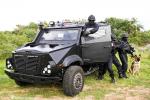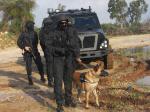ICDS/GS » Fort 1
ISDS is introducing the Fort 1 armored combat vehicle at LAAD Security 2012; the vehicle was developed under a joint venture of two Israeli companies, ISDS and Global Shield, and it reflects the latest mission requirements drafted by Brazil’s special forces as well as following requests from other clients all responsible for maintaining law and citizen security many times under strenuous circumstances and adversarial environments. The prototype vehicle is expected to be used in the next months by several Brazilian special. ISDS designed the Fort 1 as the ultimate combat vehicle for operations in all terrains and areas, including dense, mountainous urban areas. In fact, its modular design can configure to vehicle for a different missions, meeting customer requirement in a quick and economical way.
As a vehicle designed for various missions, the Fort 1 is relatively narrow, yet maintains spacious internal space for the combat team. Its turning radius is 7 meters. To be able to overcome obstacles such as oil spills or barricades, the Fort 1 is equipped with an anti-skid mechanism enabling it to cross slippery patches of road; the vehicle it can also be fitted with an obstacle breeching blade. The powerful engine and high power to weight ratio ensures that the vehicle maintains traction even on steep slopes. The capsule has 360 degree protection against ballistic threats, blast, or impact (of stones or other objects thrown at it from rooftops). The armored transparent windows are fitted with unique firing ports designed by Global Shield, offering unrestricted firing angles. The vehicle has two rear doors, enabling rapid exit. The vehicle also has two side doors equipped with armored protection to guard dismounting team members.
The Fort 1 is ready to be fitted with a network-ready system of connecting computers, on-board sensors, soldier gear, and communications links to the forward command element. The network, sensors, and electronic systems were developed especially by the RAD-BYNET group, a leading Israeli technology group. The vehicle’s network supports a number of laptop computers, and provides a communication service that extends wireless connectivity beyond the vehicle itself, thus enabling the team to dismount while maintaining full connectivity with the vehicle and the tactical command post. The vehicle can be fitted with panoramic video cameras covering 360 degrees, offering the team a situational picture from inside the vehicle. The vehicle can be equipped with various weapon systems, including non-lethal munitions and active acoustic devices for crowd dispersal.





